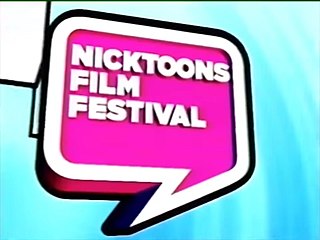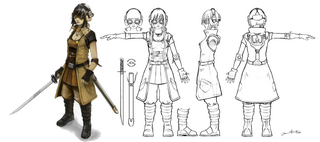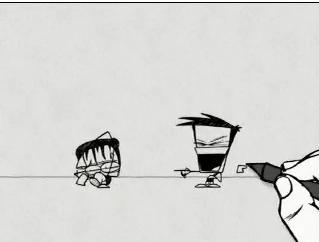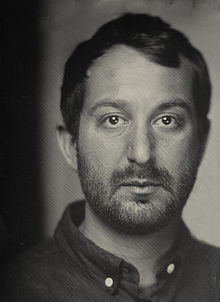
Animation is a filmmaking technique by which still images are manipulated to create moving images. In traditional animation, images are drawn or painted by hand on transparent celluloid sheets (cels) to be photographed and exhibited on film. Animation has been recognized as an artistic medium, specifically within the entertainment industry. Many animations are computer animations made with computer-generated imagery (CGI). Stop motion animation, in particular claymation, has continued to exist alongside these other forms.

ASCII art is a graphic design technique that uses computers for presentation and consists of pictures pieced together from the 95 printable characters defined by the ASCII Standard from 1963 and ASCII compliant character sets with proprietary extended characters. The term is also loosely used to refer to text-based visual art in general. ASCII art can be created with any text editor, and is often used with free-form languages. Most examples of ASCII art require a fixed-width font such as Courier for presentation.

Computer animation is the process used for digitally generating moving images. The more general term computer-generated imagery (CGI) encompasses both still images and moving images, while computer animation only refers to moving images. Modern computer animation usually uses 3D computer graphics.
While the history of animation began much earlier, this article is concerned with the development of the medium after the emergence of celluloid film in 1888, as produced for theatrical screenings, television and (non-interactive) home video.

Traditional animation is an animation technique in which each frame is drawn by hand. The technique was the dominant form of animation in cinema until the end of the 20th century, when there was a shift to computer animation in the industry, specifically 3D computer animation.

A stick figure, or stick man, is a very simple drawing of a person composed of a few lines and a circle. Often drawn by children, stick figures are known for their simplistic style. The head is most often represented by a circle, which can be a solid color or embellished with details such as eyes, a mouth, or hair. The arms, legs, torso, and abdomen are usually represented with straight lines. Details such as hands, feet, and a neck may be present or absent; simpler stick figures often display an ambiguous emotional expression or disproportionate limbs.

The Nicktoons Film Festival was an annual event that was created by producer Fred Seibert and produced for its first three years by his Frederator Studios.
A cel, short for celluloid, is a transparent sheet on which objects are drawn or painted for traditional, hand-drawn animation. Actual celluloid was used during the first half of the 20th century, but since it was flammable and dimensionally unstable it was largely replaced by cellulose acetate. With the advent of computer-assisted animation production, the use of cels has been all but abandoned in major productions. Disney studios stopped using cels in 1990 when Computer Animation Production System (CAPS) replaced this element in their animation process, and in the next decade and a half, the other major animation studios phased cels out as well.

In visual arts, a model sheet, also known as a character board, character sheet, character study or simply a study, is a document used to help standardize the appearance, poses, and gestures of a character in arts such as animation, comics, and video games.

Walt Disney Animation Studios (WDAS), sometimes shortened to Disney Animation, is an American animation studio that creates animated features and short films for The Walt Disney Company. The studio's current production logo features a scene from its first synchronized sound cartoon, Steamboat Willie (1928). Founded on October 16, 1923, by brothers Walt Disney and Roy O. Disney, it is the oldest-running animation studio in the world. It is currently organized as a division of Walt Disney Studios and is headquartered at the Roy E. Disney Animation Building at the Walt Disney Studios lot in Burbank, California. Since its foundation, the studio has produced 62 feature films, from Snow White and the Seven Dwarfs (1937) to Wish (2023), and hundreds of short films.

Adobe Flash animation is an animation that is created with the Adobe Animate platform or similar animation software and often distributed in the SWF file format. The term Adobe Flash animation refers to both the file format and the medium in which the animation is produced. Adobe Flash animation has enjoyed mainstream popularity since the mid-2000s, with many Adobe Flash-animated television series, television commercials, and award-winning online shorts being produced since then.

Doodlez is a Canadian animated shorts series produced for television by Cellar Door Productions, animated by Trapeze Animation Studios, which started airing on Teletoon in 2002. It was seen on Nicktoons and was one of the final programs shown on BBC Kids.

"Do the Evolution" is a song by American rock band Pearl Jam. Featuring lyrics written by vocalist Eddie Vedder and music written by guitarist Stone Gossard, "Do the Evolution" is the seventh track on the band's fifth studio album, Yield (1998). Despite the lack of a commercial single release, the song managed to reach number 33 on the Billboard Modern Rock Tracks chart. The song was included on Pearl Jam's 2004 greatest hits album, rearviewmirror . It was the first of the band's songs to receive a music video since "Oceans", the final single from the group's 1991 debut Ten.

Motion graphics are pieces of animation or digital footage that create the illusion of motion or rotation, and are usually combined with audio for use in multimedia projects. Motion graphics are usually displayed via electronic media technology, but may also be displayed via manual powered technology. The term distinguishes static graphics from those with a transforming appearance over time, without over-specifying the form. While any form of experimental or abstract animation can be called motion graphics, the term typically more explicitly refers to the commercial application of animation and effects to video, film, TV, and interactive applications.

Rubber hose animation was the first animation style that became standardized in the American animation field. The defining feature is a curving motion that most animated objects possess, resembling the motion and physical properties of a rubber hose. While the style fell out of fashion by the mid-1930s, it has seen a renewed interest in recent years.

Jake Parker is an American comics short-story creator, concept artist, illustrator, and animator. Parker worked as a set designer for Blue Sky Studios where he contributed to the animated films Horton Hears a Who, Rio and Epic. Parker is a children's book illustrator; his work includes the 2015 New York Times bestseller The Little Snowplow. In 2016, he wrote and illustrated his first children's book Little Bot and Sparrow which was inspired by his "Robot and Sparrow" comic. He is the creator of Inktober, a popular annual ink drawing celebration during October.
James Duesing is an American animator and educator. He has worked in many forms of animation, from traditional hand drawn and early digital work to 3D and motion capture projects. His 1990 animation Maxwell's Demon is considered one of the earliest examples of creative use of desktop computing for animation production. Duesing has taught at The University of Cincinnati, College of Design, Architecture, Art and Planning and is a professor at Carnegie Mellon University.
Mercury Filmworks is a Canadian independent animation studio based in Ottawa, Ontario. The studio was originally founded in Vancouver by Clint Eland, the current CEO, in 1997. Mercury Filmworks has produced animated television series and feature films for a variety of companies, including Disney, Netflix, Amazon Studios, and Warner Bros. Its recent projects include Kid Cosmic, Centaurworld, Hilda, The Wonderful World of Mickey Mouse, and The Ghost and Molly McGee. The studio has won Emmy Awards for its work in several categories, most recently for Hilda.
Sun Xun is a Chinese artist who works across many mediums including but not limited to acrylic, ink, pastel, traditional animation, and many forms of printmaking like woodcut. Sun is considered one of China's most prolific young artists and has received international acclaim.













